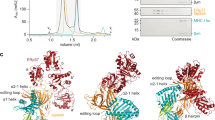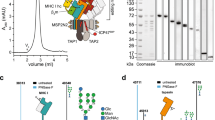Abstract
The function of the oxidoreductase ERp57 in the major histocompatibility complex (MHC) class I peptide-loading complex has remained elusive. Here we show that in the absence of tapasin, the α2 disulfide bond in the MHC class I peptide-binding groove was rapidly reduced. Covalent sequestration of ERp57 by tapasin was needed to protect the α2 disulfide bond against reduction and thus to maintain the binding groove in a peptide-receptive state. Allelic variations in MHC class I tapasin dependency reflected their susceptibility to reduction of the α2 disulfide bond. In the absence of sequestration, ERp57 acted directly on the α2 disulfide bond. Our work provides insight into how the immune system customizes 'quality control' in the endoplasmic reticulum to fit the needs of antigen presentation.
This is a preview of subscription content, access via your institution
Access options
Subscribe to this journal
Receive 12 print issues and online access
$209.00 per year
only $17.42 per issue
Buy this article
- Purchase on Springer Link
- Instant access to full article PDF
Prices may be subject to local taxes which are calculated during checkout







Similar content being viewed by others
References
Pamer, E. & Cresswell, P. Mechanisms of MHC class I–restricted antigen processing. Annu. Rev. Immunol. 16, 323–358 (1998).
Bouvier, M. Accessory proteins and the assembly of human class I MHC molecules: a molecular and structural perspective. Mol. Immunol. 39, 697–706 (2003).
Bjorkman, P.J. et al. Structure of the human class I histocompatibility antigen, HLA-A2. Nature 329, 506–512 (1987).
Dick, T.P. Assembly of MHC class I peptide complexes from the perspective of disulfide bond formation. Cell. Mol. Life Sci. 61, 547–556 (2004).
Cresswell, P., Ackerman, A.L., Giodini, A., Peaper, D.R. & Wearsch, P.A. Mechanisms of MHC class I-restricted antigen processing and cross-presentation. Immunol. Rev. 207, 145–157 (2005).
Momburg, F. & Tan, P. Tapasin-the keystone of the loading complex optimizing peptide binding by MHC class I molecules in the endoplasmic reticulum. Mol. Immunol. 39, 217–233 (2002).
Garbi, N., Tanaka, S., van den Broek, M., Momburg, F. & Hammerling, G.J. Accessory molecules in the assembly of major histocompatibility complex class I/peptide complexes: how essential are they for CD8+ T-cell immune responses? Immunol. Rev. 207, 77–88 (2005).
Ribaudo, R.K. & Margulies, D.H. Independent and synergistic effects of disulfide bond formation, β2-microglobulin, and peptides on class I MHC folding and assembly in an in vitro translation system. J. Immunol. 149, 2935–2944 (1992).
Wang, H., Capps, G.G., Robinson, B.E. & Zuniga, M.C. Ab initio association with β2-microglobulin during biosynthesis of the H-2Ld class I major histocompatibility complex heavy chain promotes proper disulfide bond formation and stable peptide binding. J. Biol. Chem. 269, 22276–22281 (1994).
Smith, J.D., Solheim, J.C., Carreno, B.M. & Hansen, T.H. Characterization of class I MHC folding intermediates and their disparate interactions with peptide and β2-microglobulin. Mol. Immunol. 32, 531–540 (1995).
Tector, M., Zhang, Q. & Salter, R.D. Beta 2-microglobulin and calnexin can independently promote folding and disulfide bond formation in class I histocompatibility proteins. Mol. Immunol. 34, 401–408 (1997).
Lewis, J.W. & Elliott, T. Evidence for successive peptide binding and quality control stages during MHC class I assembly. Curr. Biol. 8, 717–720 (1998).
Antoniou, A.N. et al. The oxidoreductase ERp57 efficiently reduces partially folded in preference to fully folded MHC class I molecules. EMBO J. 21, 2655–2663 (2002).
Dick, T.P., Bangia, N., Peaper, D.R. & Cresswell, P. Disulfide bond isomerization and the assembly of MHC class I-peptide complexes. Immunity 16, 87–98 (2002).
Peaper, D.R., Wearsch, P.A. & Cresswell, P. Tapasin and ERp57 form a stable disulfide-linked dimer within the MHC class I peptide-loading complex. EMBO J. 24, 3613–3623 (2005).
Williams, A.P., Peh, C.A., Purcell, A.W., McCluskey, J. & Elliott, T. Optimization of the MHC class I peptide cargo is dependent on tapasin. Immunity 16, 509–520 (2002).
Keefe, A.D., Wilson, D.S., Seelig, B. & Szostak, J.W. One-step purification of recombinant proteins using a nanomolar-affinity streptavidin-binding peptide, the SBP-Tag. Protein Expr. Purif. 23, 440–446 (2001).
Grandea, A.G., Lehner, P.J., Cresswell, P. & Spies, T. Regulation of MHC class I heterodimer stability and interaction with TAP by tapasin. Immunogenetics 46, 477–483 (1997).
Steinle, A. & Schendel, D.J. HLA class I alleles of LCL 721 and 174 x CEM.T2 (T2). Tissue Antigens 44, 268–270 (1994).
Zernich, D. et al. Natural HLA class I polymorphism controls the pathway of antigen presentation and susceptibility to viral evasion. J. Exp. Med. 200, 13–24 (2004).
Park, B. et al. Redox regulation facilitates optimal peptide selection by MHC class I during antigen processing. Cell 127, 369–382 (2006).
Stam, N., Spits, H. & Ploegh, H. Monoclonal antibodies raised against denatured HLA-B locus heavy chains permit biochemical characterization of certain HLA-C locus products. J. Immunol. 137, 2299–2306 (1986).
Sadasivan, B., Lehner, P.J., Ortmann, B., Spies, T. & Cresswell, P. Roles for calreticulin and a novel glycoprotein, tapasin, in the interaction of MHC class I molecules with TAP. Immunity 5, 103–114 (1996).
Ortmann, B., Androlewicz, M.J. & Cresswell, P. MHC class I/β2-microglobulin complexes associate with TAP transporters before peptide binding. Nature 368, 864–867 (1994).
Dick, T.P. & Cresswell, P. Thiol oxidation and reduction in major histocompatibility complex class I-restricted antigen processing and presentation. Methods Enzymol. 348, 49–54 (2002).
Garbi, N., Tanaka, S., Momburg, F. & Hammerling, G.J. Impaired assembly of the major histocompatibility complex class I peptide-loading complex in mice deficient in the oxidoreductase ERp57. Nat. Immunol. 7, 93–102 (2006).
Lindquist, J.A., Jensen, O.N., Mann, M. & Hammerling, G.J. ER-60, a chaperone with thiol-dependent reductase activity involved in MHC class I assembly. EMBO J. 17, 2186–2195 (1998).
Solda, T., Garbi, N., Hammerling, G.J. & Molinari, M. Consequences of ERp57 deletion on oxidative folding of obligate and facultative clients of the calnexin cycle. J. Biol. Chem. 281, 6219–6226 (2006).
Helenius, A. & Aebi, M. Roles of N-linked glycans in the endoplasmic reticulum. Annu. Rev. Biochem. 73, 1019–1049 (2004).
Jessop, C.E. & Bulleid, N.J. Glutathione directly reduces an oxidoreductase in the endoplasmic reticulum of mammalian cells. J. Biol. Chem. 279, 55341–55347 (2004).
Mezghrani, A. et al. Manipulation of oxidative protein folding and PDI redox state in mammalian cells. EMBO J. 20, 6288–6296 (2001).
Ellgaard, L. & Helenius, A. ER quality control: towards an understanding at the molecular level. Curr. Opin. Cell Biol. 13, 431–437 (2001).
Howarth, M., Williams, A., Tolstrup, A.B. & Elliott, T. Tapasin enhances MHC class I peptide presentation according to peptide half-life. Proc. Natl. Acad. Sci. USA 101, 11737–11742 (2004).
Zhang, Y., Baig, E. & Williams, D.B. Functions of ERp57 in the folding and assembly of major histocompatibility complex class I molecules. J. Biol. Chem. 281, 14622–14631 (2006).
Zacharias, M. & Springer, S. Conformational flexibility of the MHC class I α1-α2 domain in peptide bound and free states: a molecular dynamics simulation study. Biophys. J. 87, 2203–2214 (2004).
Elliott, T. & Williams, A. The optimization of peptide cargo bound to MHC class I molecules by the peptide-loading complex. Immunol. Rev. 207, 89–99 (2005).
Santos, S.G. et al. MHC class I-ERp57-tapasin interactions within the peptide-loading complex. J. Biol. Chem. 282, 17587–17593 (2007).
Kanaseki, T., Blanchard, N., Hammer, G.E., Gonzalez, F. & Shastri, N. ERAAP synergizes with MHC class I molecules to make the final cut in the antigenic peptide precursors in the endoplasmic reticulum. Immunity 25, 795–806 (2006).
Greenwood, R., Shimizu, Y., Sekhon, G.S. & DeMars, R. Novel allele-specific, post-translational reduction in HLA class I surface expression in a mutant human B cell line. J. Immunol. 153, 5525–5536 (1994).
Peh, C.A. et al. HLA-B27-restricted antigen presentation in the absence of tapasin reveals polymorphism in mechanisms of HLA class I peptide loading. Immunity 8, 531–542 (1998).
Diedrich, G., Bangia, N., Pan, M. & Cresswell, P. A role for calnexin in the assembly of the MHC class I loading complex in the endoplasmic reticulum. J. Immunol. 166, 1703–1709 (2001).
Lutz, P.M. & Cresswell, P. An epitope common to HLA class I and class II antigens, Ig light chains, and β2-microglobulin. Immunogenetics 25, 228–233 (1987).
Tahara, T. et al. HLA antibody responses in HLA class I transgenic mice. Immunogenetics 32, 351–360 (1990).
Call, M.E., Pyrdol, J., Wiedmann, M. & Wucherpfennig, K.W. The organizing principle in the formation of the T cell receptor-CD3 complex. Cell 111, 967–979 (2002).
Acknowledgements
We thank C. Mader for expert technical assistance; F. Momburg, N. Garbi and N. Bangia (Roswell Park Cancer Institute) for discussions; and F. Momburg and P. Cresswell (Yale University) for reagents. Supported by the Deutsche Forschungsgemeinschaft (DI 731/2-1) and the European Commission (Marie Curie Excellence Grant).
Author information
Authors and Affiliations
Contributions
T.P.D. designed the research, supervised the experiments, analyzed data and wrote the manuscript; A.K. designed experiments, did most experiments, analyzed data and contributed to the writing of the manuscript; M.P. did PDI experiments; and M.W. contributed to ERp57 depletion experiments.
Corresponding author
Ethics declarations
Competing interests
The authors declare no competing financial interests.
Supplementary information
Supplementary Text and Figures
Supplementary Figures 1–5 (PDF 1890 kb)
Rights and permissions
About this article
Cite this article
Kienast, A., Preuss, M., Winkler, M. et al. Redox regulation of peptide receptivity of major histocompatibility complex class I molecules by ERp57 and tapasin. Nat Immunol 8, 864–872 (2007). https://doi.org/10.1038/ni1483
Received:
Accepted:
Published:
Issue Date:
DOI: https://doi.org/10.1038/ni1483
This article is cited by
-
Investigational treatment suspension and enhanced cell-mediated immunity at rebound followed by drug-free remission of simian AIDS
Retrovirology (2013)
-
Effect of a tapasin mutant on the assembly of the mouse MHC class I molecule H2‐Kd
Immunology & Cell Biology (2010)
-
Protein disulphide isomerase is required for signal peptide peptidase-mediated protein degradation
The EMBO Journal (2010)
-
Regulation of antigen presentation machinery in human dendritic cells by recombinant adenovirus
Cancer Immunology, Immunotherapy (2009)
-
Molecular mechanisms of MHC class I abnormalities and APM components in human tumors
Cancer Immunology, Immunotherapy (2008)



